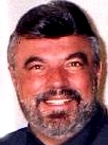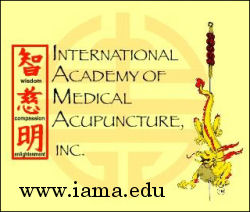Acupuncture & TCM Articles

Acupuncture Articles
by John A. Amaro L.Ac., Dipl.Ac.(NCCAOM), DC
 Dr. Amaro is an internationally known author, lecturer and practitioner beginning his practice of Acupuncture and Chiropractic in 1971. He has led 13 diplomatic Acupuncture study tours of The People's Republic of China escorting more than 500 doctors and practitioners. He has personally studied Acupuncture in nine separate Asian nations. Dr. Amaro is an internationally known author, lecturer and practitioner beginning his practice of Acupuncture and Chiropractic in 1971. He has led 13 diplomatic Acupuncture study tours of The People's Republic of China escorting more than 500 doctors and practitioners. He has personally studied Acupuncture in nine separate Asian nations.
He has received Certification in Acupuncture through the Columbia Institute of Chiropractic in 1973. This was one of the first Acupuncture postgraduate education programs for physicians in North America commencing in 1972.
He has been certified by the Waseda Acupuncture College in Tokyo, Japan in 1974 and graduated from the Chinese Medical Institute, Kowloon, China in 1976. He had previously taken postgraduate studies at the Tai Chung Medical School Taipei, China 1973.
Pain: the Primary Reason Patients See Us, and What to Do about it
John A. Amaro L.Ac., Dipl.Ac.(NCCAOM), DC
Acupuncture has been shown to be extremely effective in helping the dermatological, neurologic, circulatory, endocrine, visceral, and every other system that operates the body. Without question, however, pain is the number one reason a patient seeks our help. We as acupuncturists are extremely powerful in dealing with pain.
Having practiced acupuncture since 1972, with 13 visits to the People's Republic of China, in addition to numerous trips throughout virtually every country in Asia (with the exception of Laos), I am fortunate to have studied with some of the greatest masters and healers on the planet. Of all the procedures, techniques and philosophies I have experienced over the last 28 years, perhaps the most significant one taught to me by one of my earliest teachers is simply, "To become a master, just do what masters do."
The treatment approaches outlined here are some of the most significant protocols in acupuncture for pain. After reading this, some will say, "I already knew that." Even so, it's still a great review. I'm not too sure how many times we hear of procedures that are so effective. Remember: the more we learn, the more there is to forget. Review is essential.
Others reading this will be opened up to an entire new approach. As we explore the inner philosophies of acupuncture, we can easily see the extreme diversity this healing art has. Just as cultures, languages, foods, and art are so diametrically different in each of the Asian countries, so is the practice of acupuncture. Look over the following information. Within it will be the keys to the establishment of a successful, fulfilling practice of acupuncture, which is the effective treatment of pain.
The treatment of musculoskeletal conditions by acupuncture is legendary. There are perhaps no modalities in the professional healing arts which are as effective for specific area pain relief. As a general rule, acupuncture is most easily applied to a particular joint or area of musculoskeletal complaint, with acupuncture point stimulation at the area of complaint. This procedure, known as "surround the dragon," is one of the most classic acupuncture techniques. It is used throughout the acupuncture world and has been for centuries, but what happens when the pain is extreme and diffuse throughout the body? How do we treat? Where is our focus?
In "surround the dragon" for localized problem areas, acupuncturists simply palpate tender (ah shi) points in and around the area of complaint and stimulate them. Any form of stimulation is effective. Even though needle stimulation is most often thought of as acupuncture, it must be remembered: acupuncture is a principle, not a technique. Therefore, many forms of stimulation can be as effective as needles, including: simple electronic stimulation; non-invasive pressure stimulation through a "teishein"; moxibustion; red light laser stimulation; heat; cold; pressure; and ultrasound. In addition to "surround the dragon," traditional Chinese medicine (TCM) recognizes disease patterns which are most often connected with diffuse systemic pain and are extremely important to treat: dampness, blood vacuity (deficiency) and exterior wind.

Acupuncture in the
Treatment of Pain
Dampness is primarily associated with loose stools, fatigue, nausea, general heaviness in the body, multiple painful sites and joint stiffness with difficulty in locating an exact point of pain. The tongue is greasy and the pulse is slippery and boggy. According to TCM, the way to treat this situation is to remove dampness by supplementing the spleen.
When musculoskeletal conditions arise as a result of dampness, the condition responds remarkably well to the liberal use of moxa, which can be used through the use of a moxa stick held close to specific points or by attaching moxa to the end of the needle and allowing it to burn. A practical approach is to have the practitioner mark the points for the patient and have the patient apply warming moxa to the specific points at home through the use of a moxa stick held close to the point.
A number of very specific acupuncture points have a remarkable effect on conditions brought on by dampness, including:
GB 34 (outside of knee), the most important of all the musculoskeletal points of multiple site pain origins;
ST40, classically used to disperse phlegm;
SP 9 (inside of knee), which removes dampness;
JEN MO 9 (CV 9), which removes dampness;
SP 3 and SP 6, which supplement spleen qi;
BL 20 (associated point for the spleen);
LIV 13 (alarm point for the spleen tip of the 11th rib), a major meeting point of the viscera;
JEN MO 12 (CV 12) with CX (P) 6, which are extremely effective in conditions of nausea and constriction of the chest as a result of dampness;
ST 36, which supplements spleen qi;
SP 21, the great luo point, which deals with any systemic pain due to dampness.
Exterior wind is a common occurrence responsible for multiple muslculoskeletal pain sites. Even though exterior wind can produce multiple pain sites, it is most often associated with the neck, upper back and shoulders. Wind generally is much more of an acute pain than dampness, coming on very quickly even in the otherwise healthy individual. These conditions usually occur when the patient has been in direct wind situations, such as having a fan or air conditioning duct blowing on them. It may even occur when a patient is protected from the wind, but wind is exhibiting itself in the environment such as a very windy day.
The energy of wind in the environment is the culprit. In these situations, the extraordinary meridians become taxed, which generally produces the pain. In TCM, the tongue has a thin white coat and the pulse is considered floating. In needle therapy, using superficial stimulation is suggested. In situations where cold is combined with wind, moxa to the points are very effective. The points of significance in wind conditions are:
GB 34, a specific meeting point for all the sinews;
GB 31, which disperses wind from the lower half of the body;
LI 4, which disperses wind from the upper half of the body;
BL 12, a point in which perverse wind energy enters the body and disperses wind;
BL 10 and GB 20, points just below the occiput. These points disperse wind and also are points where wind enters the body;
BL 11, a point of significance for any bone problem;
TH 5 and GB 41, master points for the balancing of the yang wei mo and du mai. They are very significant in any multiple joint or musculoskeletal pain condition, especially as connected with arthritis;
SI 3 and BL 62, master points for multiple pain especially of the back. The points deal with the governing vessel and yang qiao mai.
GV 14 and LI 11, which are used in fever.
Blood vacuity (deficiency) creates very diffuse pain, which is relatively mild and produces discomfort on palpation throughout the body. The pain is most often described as being in the flesh as opposed to the joints or muscles. The patient generally presents appearing sick with symptoms of pale dry skin, brittleness of the nails, fatigue, insomnia, nervousness, vertigo and general emaciation. In TCM diagnosis, the pulse is thready and the tongue is pale. Treatment is focused on supplementing qi and blood and supporting the spleen. It is advised to use few needles and avoid strong stimulation. Moxa is also effective when used with a moxa stick applied to the point. Points of significance are:
ST 37 and ST 39, "sea of blood" points which are used for vague general pain with lowered energy;
SP 4, the master point for supplementing blood and affecting the spleen meridian;
SI 6, a powerful point for general pain in the elderly or very weak;
BL 11, a great bone point but also a point associated with sea of blood;
BL 20, an associated point for the spleen;
BL 17, a diaphragm point but also a meeting point of blood;
GB 34, a master point for the sinews;
SP 10, a powerful point to increase blood;
ST 36 and SP 6, which supplement the spleen and affect blood.
The points you have been presented with are some of the most classic points historically used by masters. They are simple to use and produce spectacular results. Use caution with needle stimulation, making sure not to leave the needles indwelling more than 20 minutes maximum. If you have patients use a moxa roll on the points themselves at home, remember to just warm the point as opposed to overheating it.
Since the early 1970s, acupuncture has been famous for controlling pain. Even though the medical profession as a whole was reluctant to use or even acknowledge acupuncture in its early days, it is highly endorsed and used extensively in the medical field. Even though the general doctor/physician does not necessarily understand the working mechanisms of TCM, the points mentioned here are commonplace in the medical/chiropractic approach to pain.
Remember that we all coexist in the healing professions for the express purpose of helping sick people regain their health. This can be easily accomplished provided we all have a mutual respect for the individual work that we do.
Best wishes in the Year of the Dragon!
About the Author: John Amaro has been practicing acupuncture for more than a quarter-century. After graduating from Cleveland Chiropractic College-Kansas City in 1969, he began studying acupuncture, receiving certification from the Chinese Medical Institute and Waseda Acupuncture College in Japan in 1974.
Dr. Amaro was named a diplomate in acupuncture from the National Commission for the Certification of Acupuncturists in 1985. He is also a diplomate of the National Commission for the Certification of Acupuncture (NCCA) and is a member of the National Association of Teachers of Acupuncture and Oriental Medicine. He has written more than 100 articles on acupuncture and Chinese medicine and has presented more than 1,000 educational symposiums worldwide.
|
